Energy and Environment Performance of Resource-Based Cities in China: A Non-Parametric Approach for Estimating Hyperbolic Distance Function
Abstract
1. Introduction
2. Research Methodology
2.1. HDF Model with Environmental Technology
- Approximate homogeneity: ;
- Non-decreasing for weakly disposable desirable output: ;
- Non-increasing for weakly disposable undesired outputs: ;
- Non-increasing for strong disposable inputs: .
2.2. HDF for Energy Environmental Efficiency
2.3. An Improved Non-Parameters Approach for Estimating HDF
- Reconstruct a new direction vector from DMU° to point : ;
- Solving the DMU° for the DDF model (8) and its dual model (9) with d1 as the direction vector, we can get the second pair of dual solutions and , and then obtain another supporting hyperplane equation H2: for V;
- Let the intersection of H2 and hyperbolic curve named , which satisfies the equation of the hyperplane H2, so we can get a model with the parameters and the unknown factor as the model (10). Then we solve the equation to obtain the value of ;
- Constructing a new constraint test condition Z2: , which needs to test whether is the optimal HDF solution. If true, the iteration stops, otherwise it continues to reconstruct a new directional vector from DMU° to point , and returns to step 1.
2.4. Efficiency and Malmquist Index within Global Reference
3. Material
3.1. Subject Investigated
3.2. Data Sources and Description
4. Empirical Study
4.1. Dividing Resource-Based Cites by RD
4.1.1. Using FAI to Represent RD
4.1.2. Classification by RD and Region
4.2. GEEE Analysis
4.2.1. Difference by RD
4.2.2. Difference by Region
4.3. EEPC Analysis
4.3.1. Overall EEPC
4.3.2. EEPC for Classification
4.4. Classification by Combining Static Efficiency and Dynamic Productivity Changes
5. Conclusions and Enlightenment
Author Contributions
Funding
Conflicts of Interest
References
- Zhang, M.; Tan, F.; Lu, Z. Resource-Based Cities (Rbc): A Road to Sustainability. Int. J. Sustain. Dev. World Ecol. 2014, 21, 465–470. [Google Scholar] [CrossRef]
- He, S.Y.; Lee, J.; Zhou, T.; Wu, D. Shrinking Cities and Resource-Based Economy: The Economic Restructuring in China’s Mining Cities. Cities 2017, 60, 75–83. [Google Scholar] [CrossRef]
- Li, H.; Long, R.; Chen, H. Economic Transition Policies in Chinese Resource-Based Cities: An Overview of Government Efforts. Energy Policy 2013, 55, 251–260. [Google Scholar] [CrossRef]
- Hu, J.; Wang, S. Total-Factor Energy Efficiency of Regions in China. Energy Policy 2006, 34, 3206–3217. [Google Scholar] [CrossRef]
- Chung, H.Y.; Färe, R.; Grosskopf, S. Productivity and Undesirable Outputs: A Directional Distance Function Approach. J. Environ. Manag. 1997, 51, 229–240. [Google Scholar] [CrossRef]
- Bai, Y.; Hua, C.; Jiao, J.; Yang, M.; Li, F. Green Efficiency and Environmental Subsidy: Evidence from Thermal Power Firms in China. J. Clean. Prod. 2018, 188, 49–61. [Google Scholar] [CrossRef]
- Jin, W.; Zhang, H.; Liu, S.; Zhang, H. Technological Innovation, Environmental Regulation, and Green Total Factor Efficiency of Industrial Water Resources. J. Clean. Prod. 2019, 211, 61–69. [Google Scholar] [CrossRef]
- Iram, R.; Zhang, J.; Erdogan, S.; Abbas, Q.; Mohsin, M. Economics of Energy and Environmental Efficiency: Evidence from Oecd Countries. Environ. Sci. Pollut. Res. 2020, 27, 3858–3870. [Google Scholar] [CrossRef]
- Bi, G.; Song, W.; Zhou, P.; Liang, L. Does Environmental Regulation Affect Energy Efficiency in China’s Thermal Power Generation? Empirical Evidence from a Slacks-Based Dea Model. Energy Policy 2014, 66, 537–546. [Google Scholar] [CrossRef]
- Song, M.; Peng, J.; Wang, J.; Zhao, J. Environmental Efficiency and Economic Growth of China: A Ray Slack-Based Model Analysis. Eur. J. Oper. Res. 2018, 269, 51–63. [Google Scholar] [CrossRef]
- Halkos, G.E.; Polemis, M.L. The Impact of Economic Growth on Environmental Efficiency of the Electricity Sector: A Hybrid Window Dea Methodology for the USA. J. Environ. Manag. 2018, 211, 334–346. [Google Scholar] [CrossRef] [PubMed]
- Wang, Z.; Feng, C. A Performance Evaluation of the Energy, Environmental, and Economic Efficiency and Productivity in China: An Application of Global Data Envelopment Analysis. Appl. Energy 2015, 147, 617–626. [Google Scholar] [CrossRef]
- Yang, Z.; Wei, X. The Measurement and Influences of China’s Urban Total Factor Energy Efficiency under Environmental Pollution: Based on the Game Cross-Efficiency Dea. J. Clean. Prod. 2019, 209, 439–450. [Google Scholar] [CrossRef]
- Li, L.; Lei, Y.; Pan, D.; Si, C. Research on Sustainable Development of Resource-Based Cities Based on the Dea Approach: A Case Study of Jiaozuo, China. Math. Probl. Eng. 2016, 2016, 1–10. [Google Scholar] [CrossRef]
- Li, B.; Dewan, H. Efficiency Differences among China’s Resource-Based Cities and Their Determinants. Resour. Policy 2017, 51, 31–38. [Google Scholar] [CrossRef]
- Yan, D.; Kong, Y.; Ye, B.; Shi, Y.; Zeng, X. Spatial Variation of Energy Efficiency Based on a Super-Slack-Based Measure: Evidence from 104 Resource-Based Cities. J. Clean. Prod. 2019, 240, 117669. [Google Scholar] [CrossRef]
- Tian, Z.; Ren, F.; Xiao, Q.; Chiu, Y.; Lin, T. Cross-Regional Comparative Study on Carbon Emission Efficiency of China’s Yangtze River Economic Belt Based on the Meta-Frontier. Int. J. Environ. Res. Public Health 2019, 16, 619. [Google Scholar] [CrossRef]
- Färe, R.; Grosskopf, S.; Lovell, C.A.K. The Measurement of Efficiency of Production; Springer Science & Business Media: New York, NY, USA, 1985; Volume 6. [Google Scholar]
- Glass, J.C.; McKillop, D.G.; Quinn, B.; Wilson, J. Cooperative Bank Efficiency in Japan: A Parametric Distance Function Analysis. Eur. J. Financ. 2014, 20, 291–317. [Google Scholar] [CrossRef]
- Pena, C.R.; Serrano, A.L.M.; de Britto, P.A.P.; Franco, V.R.; Guarnieri, P.; Thomé, K.M. Environmental Preservation Costs and Eco-Efficiency in Amazonian Agriculture: Application of Hyperbolic Distance Functions. J. Clean. Prod. 2018, 197, 699–707. [Google Scholar] [CrossRef]
- Duman, Y.S.; Kasman, A. Environmental Technical Efficiency in Eu Member and Candidate Countries: A Parametric Hyperbolic Distance Function Approach. Energy 2018, 147, 297–307. [Google Scholar] [CrossRef]
- Adenuga, A.H.; Davis, J.; Hutchinson, G.; Patton, M.; Donnellan, T. Environmental technical efficiency and phosphorus pollution abatement cost in dairy farms: A parametric hyperbolic distance function approach. In Proceedings of the 93rd Annual Conference, Coventry, UK, 15–17 April 2019. [Google Scholar]
- Färe, R.; Margaritis, D.; Rouse, P.; Roshdi, I. Estimating the Hyperbolic Distance Function: A Directional Distance Function Approach. Eur. J. Oper. Res. 2016, 254, 312–319. [Google Scholar] [CrossRef]
- Zhang, S.; Jiang, W. Energy Efficiency Measures: Comparative Analysis. J. Quant. Tech. Econ. 2016, 7, 3–24. [Google Scholar]
- Yu, C.; Li, H.; Jia, X.; Li, Q. Improving Resource Utilization Efficiency in China’s Mineral Resource-Based Cities: A Case Study of Chengde, Hebei Province. Resour. Conserv. Recycl. 2015, 94, 1–10. [Google Scholar] [CrossRef]
- Sun, W.; Li, Y.; Wang, D.; Fan, J. The Efficiencies and Their Changes of China’s Resources-Based Cities Employing Dea and Malmquist Index Models. J. Geogr. Sci. 2012, 22, 509–520. [Google Scholar] [CrossRef]
- Liu, X.; Meng, X. Evaluation and empirical research on the energy efficiency of 20 mining cities in Eastern and Central China. Int. J. Min. Sci. Technol. 2018, 28, 525–531. [Google Scholar] [CrossRef]
- Auty, R.M. Industrial Policy Reform in Six Large Newly Industrializing Countries: The Resource Curse Thesis. World Dev. 1994, 22, 11–26. [Google Scholar] [CrossRef]
- Sachs, J.D.; Warner, A.M. The Curse of Natural Resources. Eur. Econ. Rev. 2001, 45, 827–838. [Google Scholar] [CrossRef]
- Sala-i-Martin, X.; Subramanian, A. Addressing the Natural Resource Curse: An Illustration from Nigeria. J. Afr. Econ. 2013, 22, 570–615. [Google Scholar] [CrossRef]
- Smith, B. The Resource Curse Exorcised: Evidence from a Panel of Countries. J. Dev. Econ. 2015, 116, 57–73. [Google Scholar] [CrossRef]
- Shahbaz, M.; Ahmed, K.; Tiwari, A.K.; Jiao, Z. Resource Curse Hypothesis and Role of Oil Prices in USA. Resour. Policy 2019, 64, 101514. [Google Scholar] [CrossRef]
- Gylfason, T.; Zoega, G. Natural Resources and Economic Growth: The Role of Investment. World Econ. 2006, 29, 1091–1115. [Google Scholar] [CrossRef]
- Cuesta, R.A.; Lovell, C.K.; Zofío, J.L. Environmental Efficiency Measurement with Translog Distance Functions: A Parametric Approach. Ecol. Econ. 2009, 68, 2232–2242. [Google Scholar] [CrossRef]
- Lin, B.; Liu, H. Do Energy and Environment Efficiency Benefit from Foreign Trade?—the Case of China’s Industrial Sectors. Econ. Res. J. 2015, 9, 127–141. [Google Scholar]
- Zofio, J.L.; Lovell, C.A.K. Graph Efficiency and Productivity Measures: An Application to Us Agriculture. Appl. Econ. 2001, 33, 1433–1442. [Google Scholar] [CrossRef]
- Pastor, J.T.; Lovell, C.K. A Global Malmquist Productivity Index. Econ. Lett. 2005, 88, 266–271. [Google Scholar] [CrossRef]
- Färe, R.; Grosskopf, S.; Norris, M.; Zhang, Z. Productivity growth, technical progress, and efficiency change in industrialized countries. Am. Econ. Rev. 1994, 84, 66–83. [Google Scholar]
- Ma, L.; Hsieh, J.; Chiu, Y. A Study on the Effects of Energy and Environmental Efficiency at China’s Provincial Level. Energies 2019, 12, 591. [Google Scholar] [CrossRef]
- Zhang, S.; Jiang, W. A Re-Estimate and Decomposing of the Total Factor Productivity of China. Stat. Res. 2014, 8, 54–60. [Google Scholar]
- Shao, S.; Yang, L. Natural Resource Dependence, Human Capital Accumulation, and Economic Growth: A Combined Explanation for the Resource Curse and the Resource Blessing. Energy Policy 2014, 74, 632–642. [Google Scholar] [CrossRef]
- Zhang, F.; Deng, X.; Phillips, F.; Fang, C.; Wang, C. Impacts of Industrial Structure and Technical Progress on Carbon Emission Intensity: Evidence from 281 Cities in China. Technol. Forecast. Soc. Chang. 2020, 154, 119949. [Google Scholar] [CrossRef]
- Cheng, Z.; Li, L.; Liu, J. Natural Resource Abundance, Resource Industry Dependence and Economic Green Growth in China. Resour. Policy 2020, 68, 101734. [Google Scholar] [CrossRef]
- Wang, K.; Wu, M.; Sun, Y.; Shi, X.; Sun, A.; Zhang, P. Resource Abundance, Industrial Structure, and Regional Carbon Emissions Efficiency in China. Resour. Policy 2019, 60, 203–214. [Google Scholar] [CrossRef]
- Wang, Y.; Chen, X. Natural Resource Endowment and Ecological Efficiency in China: Revisiting Resource Curse in the Context of Ecological Efficiency. Resour. Policy 2020, 66, 101610. [Google Scholar] [CrossRef]
- Dan, Y.; Kong, Y.; Ren, X.; Shi, Y.; Chiang, S. The Determinants of Urban Sustainability in Chinese Resource-Based Cities: A Panel Quantile Regression Approach. Sci. Total Environ. 2019, 686, 210–219. [Google Scholar]
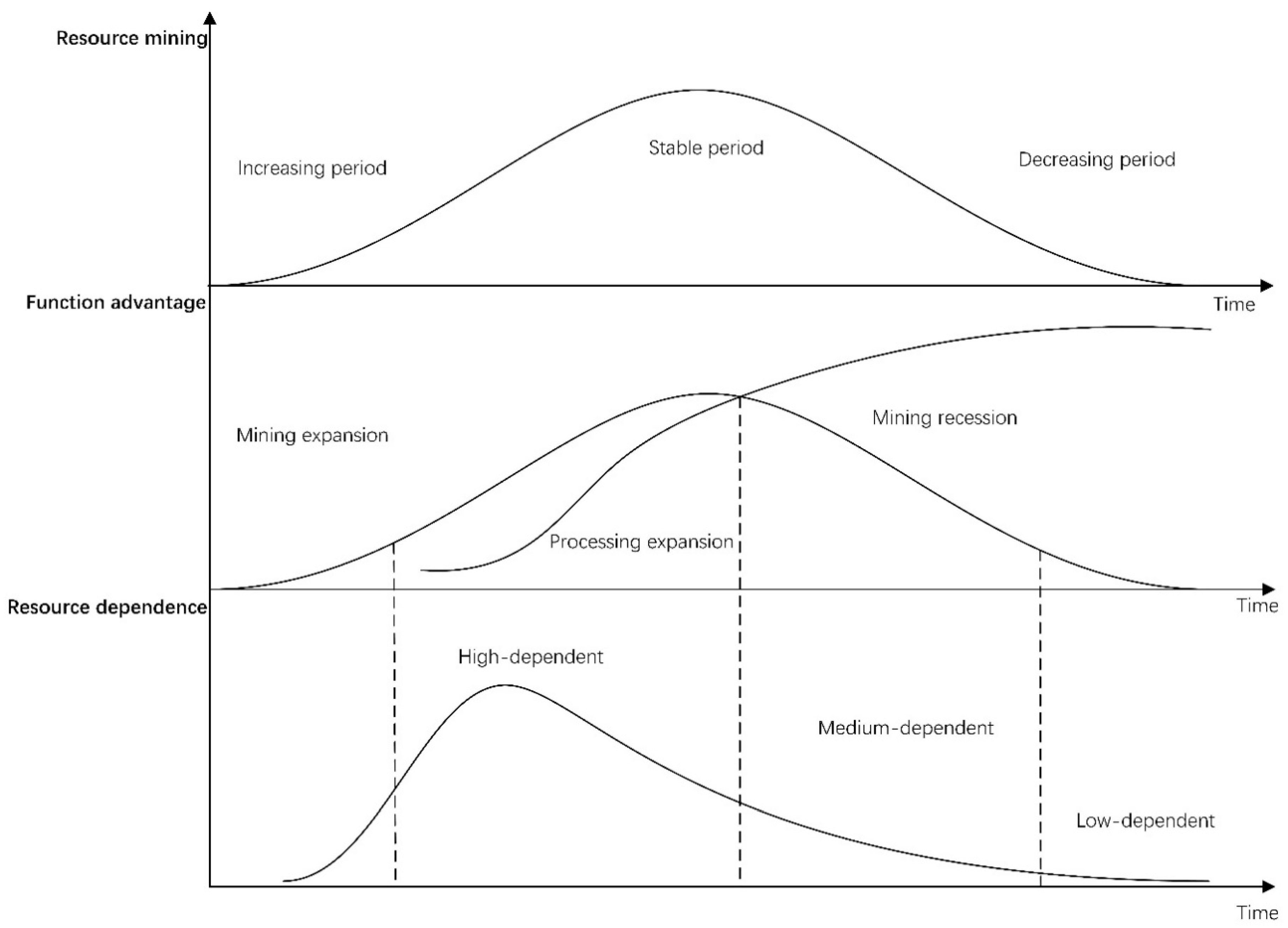
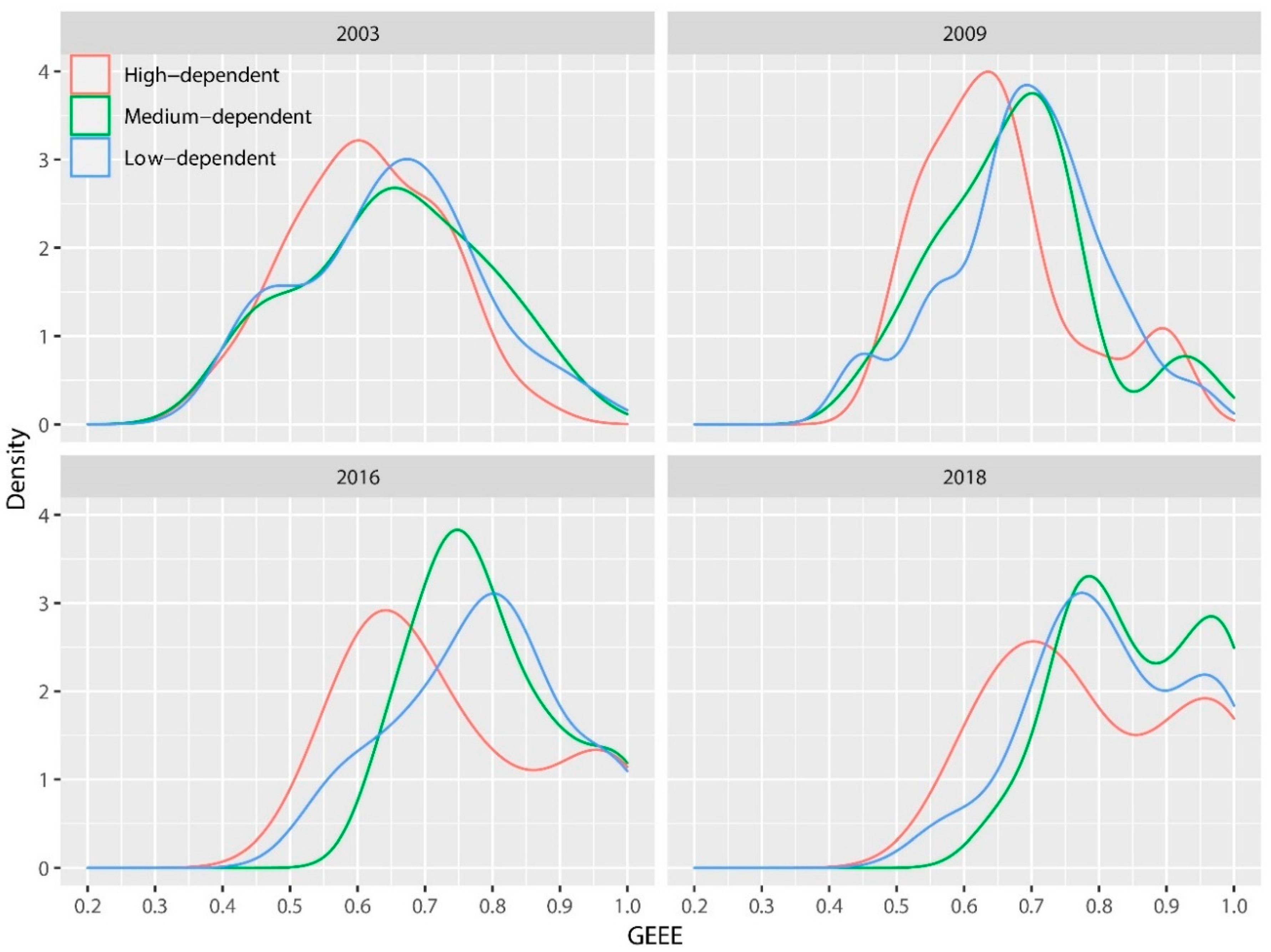
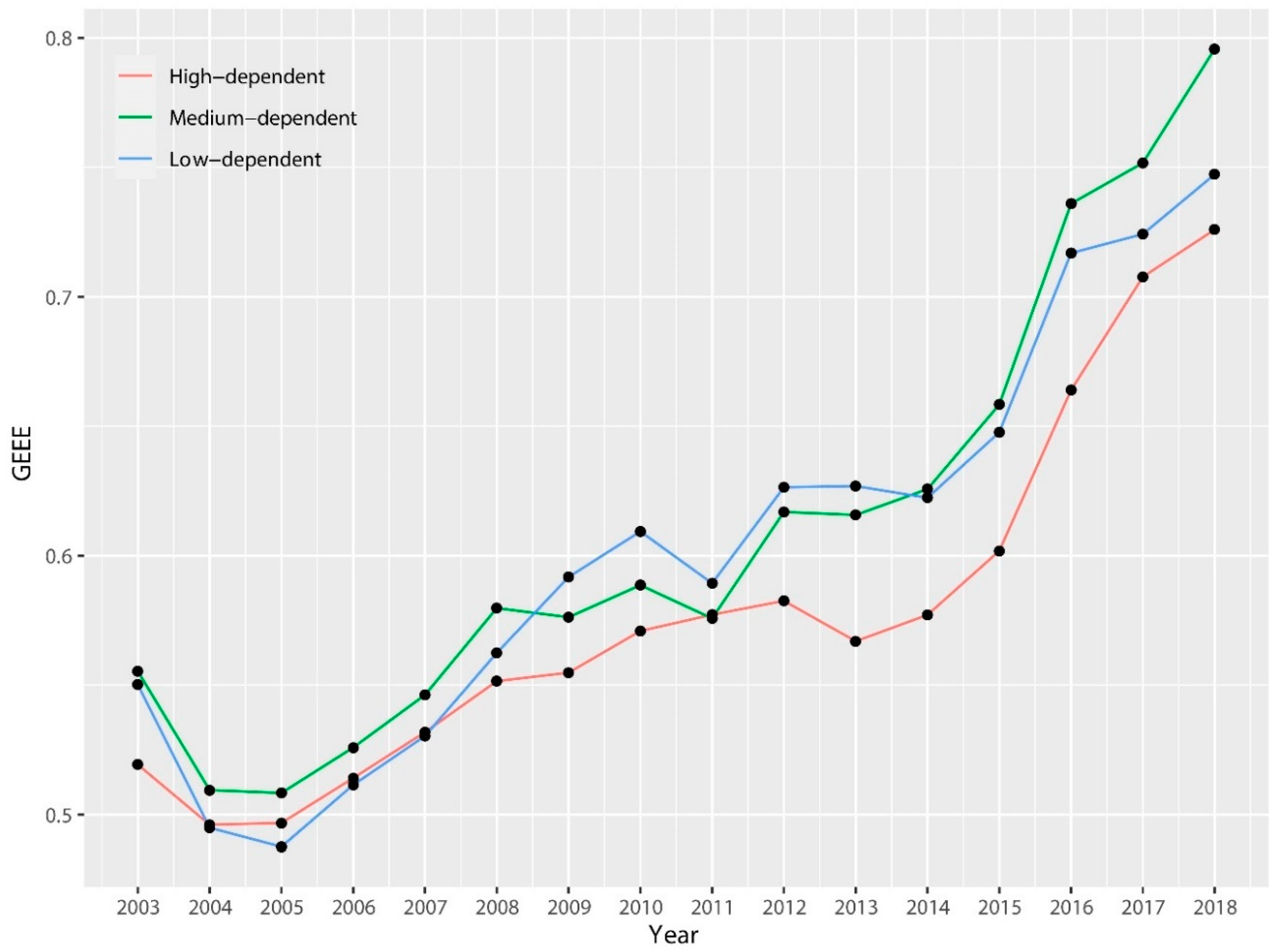
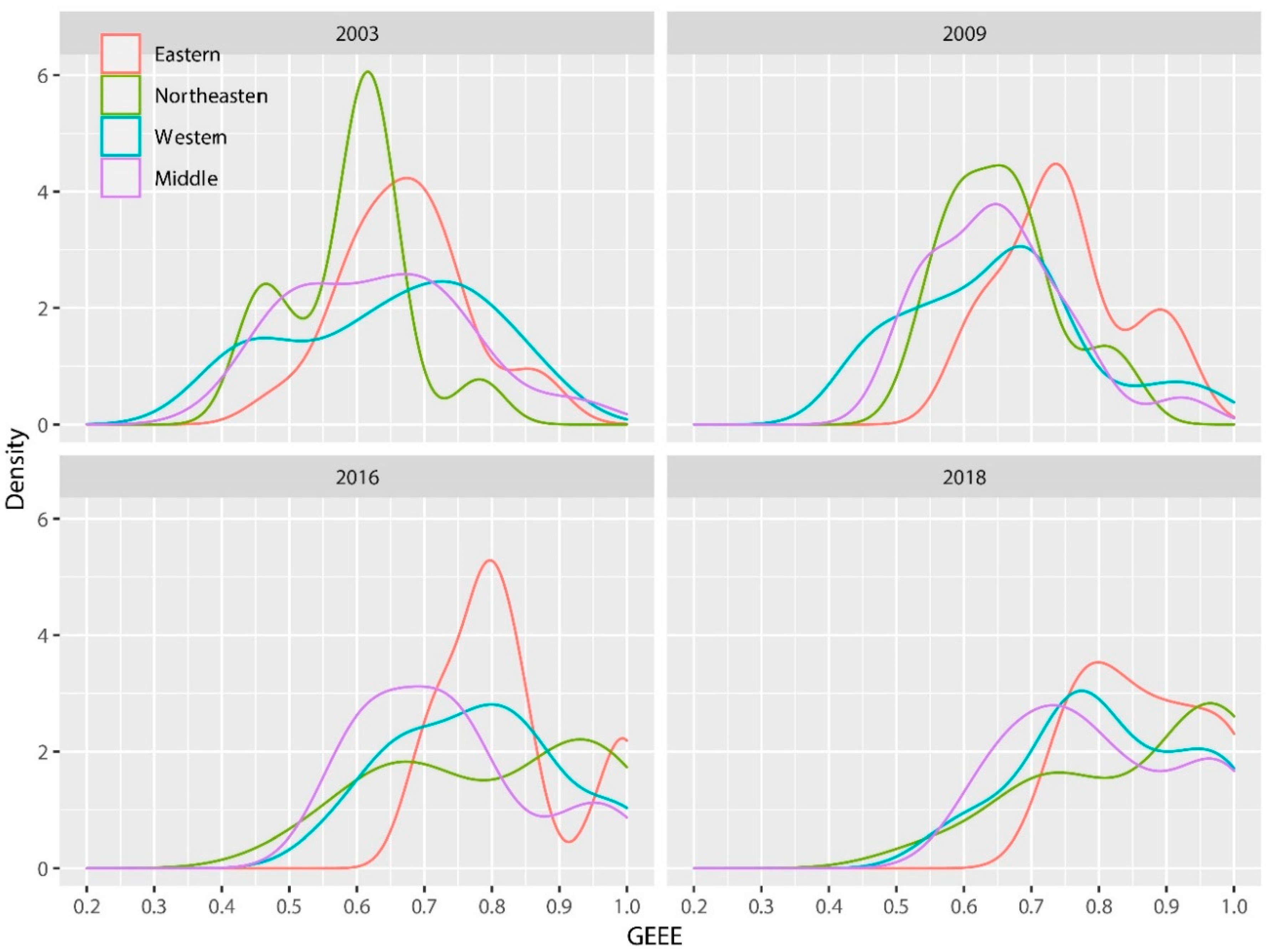
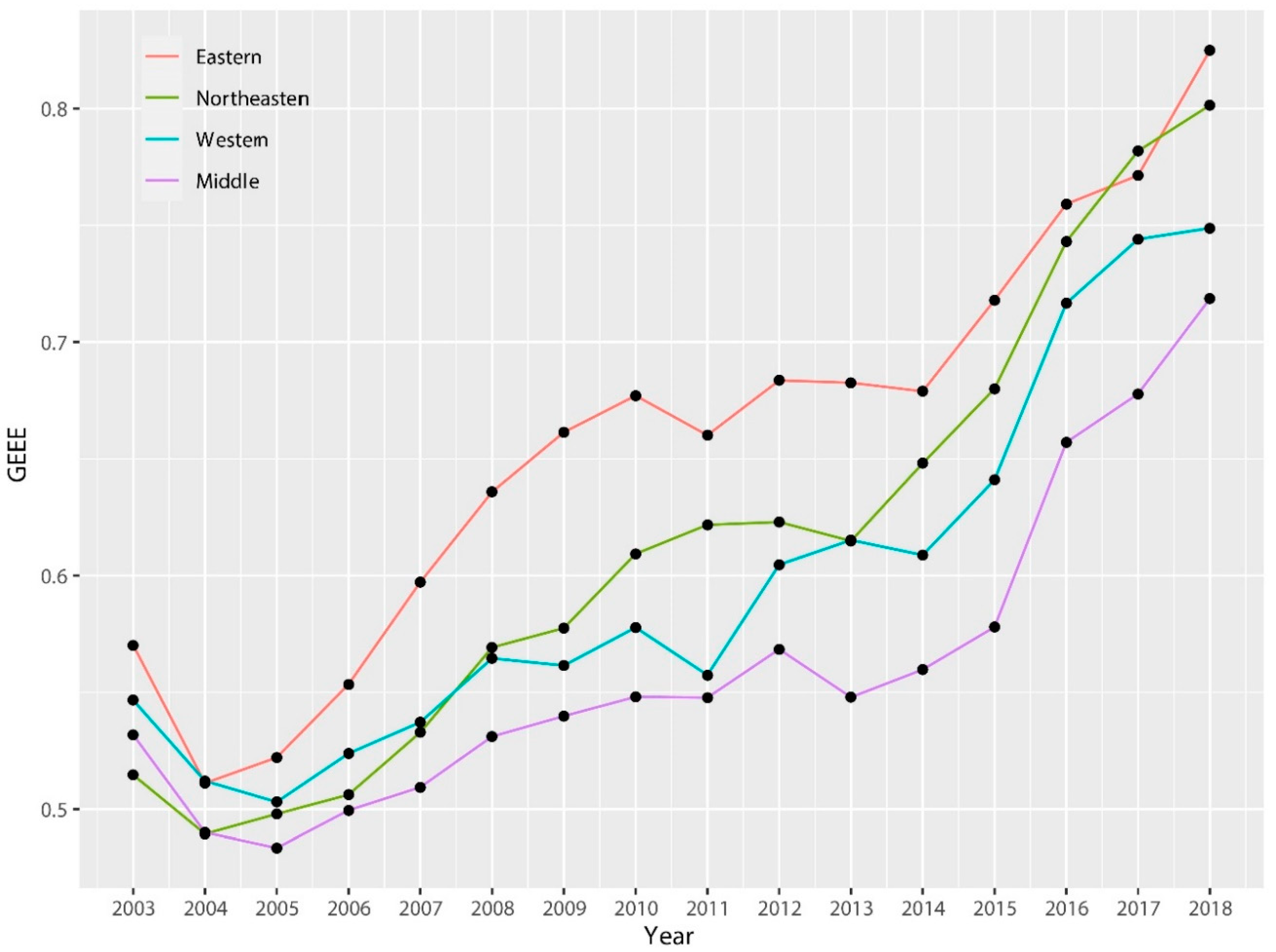
| Type | Vars | Unit | N | Mean | sd | Min | Max |
|---|---|---|---|---|---|---|---|
| input | k | million yuan | 1712 | 62,869.57 | 55,258.67 | 7967.23 | 245,883.17 |
| l | person | 1712 | 53.71 | 32.20 | 14.58 | 146.67 | |
| e | million kwh | 1712 | 567,860.18 | 612,544.50 | 28,967.63 | 2,687,428.3 | |
| desirable output | g | million yuan | 1712 | 83,888.51 | 81,698.09 | 10,762.87 | 365,580.88 |
| undesirable output | s | ton | 1712 | 60,857.38 | 51,269.11 | 3,555.75 | 212,108.63 |
| w | million tons | 1712 | 4718.80 | 3867.93 | 397.78 | 16,080.38 | |
| d | ton | 1712 | 32,008.55 | 31,184.83 | 2070.83 | 141,027.43 |
| High-Dependent (37) | Medium-Dependent (41) | Low-Dependent (29) | ||||||
|---|---|---|---|---|---|---|---|---|
| City | Region | City | Region | City | Region | |||
| Qitaihe | 8.529 | Northeastern | Ordos | 0.980 | Western | Zibo | 0.161 | Eastern |
| Qingyang | 8.086 | Western | Zhaotong | 0.984 | Western | Sanming | 0.166 | Eastern |
| Hegang | 4.811 | Northeastern | Suzhou | 0.935 | Central | Lincang | 0.157 | Western |
| Yan’An | 4.741 | Western | Guangyuan | 0.933 | Western | Xianyang | 0.163 | Western |
| Huaibei | 4.693 | Central | Chifeng | 0.875 | Western | Baoshan | 0.105 | Western |
| Shuangyashan | 4.489 | Northeastern | Linfen | 0.870 | Central | Ezhou | 0.131 | Central |
| Yangquan | 4.352 | Central | Chenzhou | 0.787 | Central | Ganzhou | 0.108 | Central |
| Pingliang | 3.866 | Western | Tai’An | 0.735 | Eastern | Linyi | 0.127 | Eastern |
| Jincheng | 3.852 | Central | Dazhou | 0.721 | Western | Chizhou | 0.106 | Central |
| Huainan | 3.803 | Central | Xuzhou | 0.683 | Eastern | Shaoguan | 0.114 | Eastern |
| Jixi | 3.578 | Northeastern | Weinan | 0.621 | Western | Luyang | 0.081 | Central |
| Guangan | 3.542 | Western | Pingxiang | 0.617 | Central | Pu’Er | 0.062 | Western |
| Songyuan | 3.453 | Northeastern | Handan | 0.620 | Eastern | Chuzhou | 0.072 | Central |
| Shuozhou | 3.300 | Central | Baiyin | 0.631 | Western | Xinyu | 0.076 | Central |
| Datong | 2.770 | Central | Qujing | 0.594 | Western | Baotou | 0.070 | Western |
| Panjin | 2.612 | Northeastern | Yichun | 0.498 | Central | Yunfu | 0.057 | Eastern |
| Kalamay | 2.612 | Western | Fushun | 0.433 | Northeastern | Huzhou | 0.056 | Eastern |
| Fuxin | 2.323 | Northeastern | Tangshan | 0.433 | Eastern | Shizuishan | 0.038 | Western |
| Liupanshui | 2.116 | Western | Xingtai | 0.419 | Eastern | Baoji | 0.047 | Western |
| Liaoyuan | 2.039 | Northeastern | Shaoyang | 0.373 | Central | Hezhou | 0.043 | Central |
| Tongchuan | 2.017 | Western | Hechi | 0.345 | Central | Anshan | 0.037 | Northeastern |
| Dongying | 1.708 | Eastern | Jiaozuo | 0.322 | Central | Luzhou | 0.031 | Western |
| Yulin | 1.677 | Western | Baise | 0.318 | Central | Tongling | 0.032 | Central |
| Sanmenxia | 1.656 | Central | Loudi | 0.316 | Central | Nanping | 0.029 | Eastern |
| Puyang | 1.557 | Central | Zhangjiakou | 0.308 | Eastern | Xuancheng | 0.019 | Central |
| Daqing | 1.523 | Northeastern | Huangshi | 0.284 | Central | Nanchong | 0.013 | Western |
| Hulun Buir | 1.423 | Western | Longyan | 0.281 | Eastern | Yuncheng | 0.023 | Central |
| Jinzhong | 1.421 | Central | Panzhihua | 0.250 | Western | Suqian | 0.020 | Eastern |
| Wuhai | 1.410 | Western | Ma’Anshan | 0.243 | Central | Jinchang | 0.007 | Western |
| Xinzhou | 1.391 | Central | Wuwei | 0.243 | Western | |||
| Zaozhuang | 1.337 | Eastern | Chengde | 0.251 | Eastern | |||
| Longnan | 1.303 | Western | Anshun | 0.205 | Western | |||
| Jining | 1.191 | Eastern | Tonghua | 0.218 | Northeastern | |||
| Lvliang | 1.147 | Central | Zhangye | 0.210 | Western | |||
| Hebi | 1.149 | Central | Huludao | 0.219 | Northeastern | |||
| Changzhi | 1.134 | Central | Ya’An | 0.220 | Western | |||
| Pingdingshan | 1.100 | Central | Laiwu | 0.215 | Eastern | |||
| Bozhou | 0.211 | Central | ||||||
| Hengyang | 0.191 | Central | ||||||
| Benxi | 0.167 | Northeastern | ||||||
| Nanyang | 0.183 | Central | ||||||
| Year | EEPC | EC | PEC | TC | SEEC |
|---|---|---|---|---|---|
| 2004 | 0.925 | 1.008 | 1.016 | 0.918 | 0.992 |
| 2005 | 0.921 | 1.041 | 1.035 | 0.885 | 1.006 |
| 2006 | 0.957 | 1.016 | 1.017 | 0.942 | 0.998 |
| 2007 | 0.992 | 1.027 | 1.018 | 0.966 | 1.009 |
| 2008 | 1.044 | 1.009 | 1.010 | 1.035 | 0.999 |
| 2009 | 1.058 | 0.989 | 1.008 | 1.071 | 0.981 |
| 2010 | 1.086 | 0.973 | 1.003 | 1.117 | 0.970 |
| 2011 | 1.072 | 0.976 | 0.999 | 1.097 | 0.978 |
| 2012 | 1.122 | 1.002 | 1.012 | 1.120 | 0.990 |
| 2013 | 1.111 | 0.958 | 0.970 | 1.160 | 0.987 |
| 2014 | 1.123 | 0.930 | 0.954 | 1.207 | 0.975 |
| 2015 | 1.174 | 0.910 | 0.942 | 1.290 | 0.966 |
| 2016 | 1.303 | 0.940 | 0.961 | 1.387 | 0.978 |
| 2017 | 1.347 | 0.986 | 0.982 | 1.366 | 1.003 |
| 2018 | 1.400 | 0.966 | 0.973 | 1.449 | 0.993 |
| Average growth | 1.026 | 0.997 | 0.998 | 1.029 | 0.999 |
| RD | Year | 2004 | 2006 | 2008 | 2010 | 2012 | 2014 | 2016 | 2018 | Growth | Contribution |
|---|---|---|---|---|---|---|---|---|---|---|---|
| Low | EEPC | 0.900 | 0.930 | 1.022 | 1.108 | 1.139 | 1.131 | 1.303 | 1.358 | 2.06% | 100.00% |
| TC | 0.893 | 0.930 | 1.038 | 1.129 | 1.120 | 1.185 | 1.359 | 1.421 | 2.37% | 115.02% | |
| EC | 1.007 | 1.000 | 0.985 | 0.981 | 1.017 | 0.954 | 0.959 | 0.956 | −0.30% | −14.67% | |
| PEC | 1.016 | 1.008 | 0.991 | 1.007 | 1.038 | 0.973 | 0.961 | 0.959 | −0.28% | −13.47% | |
| SEC | 0.992 | 0.992 | 0.994 | 0.974 | 0.980 | 0.981 | 0.998 | 0.996 | −0.02% | −1.21% | |
| Medium | EEPC | 0.917 | 0.947 | 1.044 | 1.060 | 1.111 | 1.127 | 1.325 | 1.433 | 2.43% | 100.00% |
| TC | 0.915 | 0.931 | 1.021 | 1.094 | 1.089 | 1.179 | 1.355 | 1.423 | 2.38% | 98.18% | |
| EC | 1.003 | 1.017 | 1.023 | 0.969 | 1.020 | 0.956 | 0.978 | 1.007 | 0.04% | 1.78% | |
| PEC | 1.019 | 1.017 | 1.026 | 1.001 | 1.036 | 0.980 | 0.996 | 1.002 | 0.01% | 0.46% | |
| SEC | 0.984 | 1.000 | 0.997 | 0.967 | 0.985 | 0.975 | 0.982 | 1.005 | 0.03% | 1.32% | |
| High | EEPC | 0.955 | 0.990 | 1.062 | 1.099 | 1.122 | 1.111 | 1.279 | 1.398 | 2.26% | 100.00% |
| TC | 0.942 | 0.964 | 1.048 | 1.133 | 1.156 | 1.255 | 1.445 | 1.500 | 2.74% | 121.31% | |
| EC | 1.014 | 1.027 | 1.013 | 0.971 | 0.971 | 0.885 | 0.885 | 0.932 | −0.47% | −20.74% | |
| PEC | 1.013 | 1.025 | 1.008 | 1.002 | 0.967 | 0.913 | 0.923 | 0.953 | −0.32% | −14.19% | |
| SEC | 1.001 | 1.001 | 1.005 | 0.969 | 1.004 | 0.970 | 0.958 | 0.978 | −0.15% | −6.57% |
| Region | Year | 2004 | 2006 | 2008 | 2010 | 2012 | 2014 | 2016 | 2018 | Growth | Contribution |
|---|---|---|---|---|---|---|---|---|---|---|---|
| Eastern | EEPC | 0.896 | 0.971 | 1.115 | 1.187 | 1.199 | 1.191 | 1.331 | 1.447 | 2.49% | 100.00% |
| TC | 0.931 | 1.002 | 1.179 | 1.280 | 1.246 | 1.290 | 1.464 | 1.532 | 2.89% | 115.81% | |
| EC | 0.963 | 0.969 | 0.946 | 0.928 | 0.962 | 0.923 | 0.909 | 0.944 | −0.38% | −15.36% | |
| PEC | 0.987 | 0.963 | 0.961 | 0.957 | 0.974 | 0.942 | 0.935 | 0.936 | −0.44% | −17.66% | |
| SEC | 0.976 | 1.006 | 0.984 | 0.969 | 0.988 | 0.979 | 0.972 | 1.009 | 0.06% | 2.31% | |
| Northeastern | EEPC | 0.951 | 0.984 | 1.106 | 1.184 | 1.210 | 1.259 | 1.444 | 1.557 | 3.00% | 100.00% |
| TC | 0.936 | 0.985 | 1.096 | 1.196 | 1.205 | 1.339 | 1.460 | 1.643 | 3.37% | 112.30% | |
| EC | 1.016 | 0.998 | 1.009 | 0.990 | 1.004 | 0.940 | 0.989 | 0.948 | −0.36% | −11.90% | |
| PEC | 1.015 | 0.990 | 1.020 | 1.028 | 1.004 | 0.982 | 1.044 | 0.998 | −0.01% | −0.38% | |
| SEC | 1.000 | 1.008 | 0.989 | 0.963 | 1.001 | 0.958 | 0.948 | 0.949 | −0.35% | −11.52% | |
| Western | EEPC | 0.937 | 0.958 | 1.033 | 1.057 | 1.106 | 1.114 | 1.311 | 1.370 | 2.12% | 100.00% |
| TC | 0.916 | 0.905 | 0.979 | 1.064 | 1.064 | 1.143 | 1.344 | 1.368 | 2.11% | 99.70% | |
| EC | 1.023 | 1.059 | 1.055 | 0.993 | 1.040 | 0.974 | 0.975 | 1.001 | 0.01% | 0.29% | |
| PEC | 1.029 | 1.062 | 1.065 | 1.035 | 1.061 | 1.030 | 1.022 | 1.025 | 0.16% | 7.68% | |
| SEC | 0.995 | 0.997 | 0.991 | 0.960 | 0.980 | 0.945 | 0.954 | 0.977 | −0.16% | −7.37% | |
| Middle | EEPC | 0.922 | 0.939 | 0.999 | 1.031 | 1.069 | 1.053 | 1.236 | 1.351 | 2.03% | 100.00% |
| TC | 0.908 | 0.931 | 0.995 | 1.060 | 1.080 | 1.177 | 1.361 | 1.415 | 2.34% | 115.42% | |
| EC | 1.015 | 1.009 | 1.003 | 0.973 | 0.990 | 0.894 | 0.908 | 0.955 | −0.31% | −15.07% | |
| PEC | 1.020 | 1.018 | 0.987 | 0.991 | 0.993 | 0.889 | 0.895 | 0.940 | −0.41% | −20.24% | |
| SEC | 0.995 | 0.991 | 1.016 | 0.981 | 0.996 | 1.006 | 1.014 | 1.016 | 0.11% | 5.19% |
| Group | City |
|---|---|
| HH (24) | Anshan, Chifeng, Daqing, Dongying, Handan, Hengyang, Huludao, Jixi, Jining, Liaoyuan, Luzhou, Luyang, Nanchong, Nanyang, Puyang, Sanmenxia, Songyuan, Tai’An, Tonghua, Xianyang, Xuzhou, Ya’An, Zaozhuang, Zibo |
| HL (27) | Baoshan, Bozhou, Chuzhou, Dazhou, Ordos, Ganzhou, Guangan, Hechi, Hulun Buir, Huzhou, Lincang, Linyi, Longyan, Longnan, Nanping, Pu’Er, Qingyang, Sanming, Shaoyang, Weinan, Suqian, Suzhou, Xuancheng, Yan’An, Yichun, Yunfu, Zhaotong |
| LH (31) | Baiyin, Baotou, Baoji, Benxi, Chengde, Datong, Ezhou, Fushun, Fuxin, Guangyuan, Hebi, Huaibei, Huainan, Huangshi, Jiaozuo, Laiwu, Liupanshui, Loudi, Ma’Anshan, Panzhihua, Panjin, Pingdingshan, Pingxiang, Shaoguan, Tangshan, Tongchuan, Tongling, Wuhai, Xinyu, Yangquan, Zhangye |
| LL (25) | Anshun, Baise, Chenzhou, Chizhou, Hezhou, Hegang, Jinchang, Jincheng, Jinzhong, Kalamay, Linfen, Lvliang, Pingliang, Qitaihe, Qujing, Shizuishan, Shuangyashan, Shuozhou, Wuwei, Xinzhou, Xingtai, Yulin, Yuncheng, Zhangjiakou, Changzhi |
© 2020 by the authors. Licensee MDPI, Basel, Switzerland. This article is an open access article distributed under the terms and conditions of the Creative Commons Attribution (CC BY) license (http://creativecommons.org/licenses/by/4.0/).
Share and Cite
Hu, Y.; Yan, T.-H.; Chen, F.-W. Energy and Environment Performance of Resource-Based Cities in China: A Non-Parametric Approach for Estimating Hyperbolic Distance Function. Int. J. Environ. Res. Public Health 2020, 17, 4795. https://doi.org/10.3390/ijerph17134795
Hu Y, Yan T-H, Chen F-W. Energy and Environment Performance of Resource-Based Cities in China: A Non-Parametric Approach for Estimating Hyperbolic Distance Function. International Journal of Environmental Research and Public Health. 2020; 17(13):4795. https://doi.org/10.3390/ijerph17134795
Chicago/Turabian StyleHu, Yao, Tai-Hua Yan, and Feng-Wen Chen. 2020. "Energy and Environment Performance of Resource-Based Cities in China: A Non-Parametric Approach for Estimating Hyperbolic Distance Function" International Journal of Environmental Research and Public Health 17, no. 13: 4795. https://doi.org/10.3390/ijerph17134795
APA StyleHu, Y., Yan, T.-H., & Chen, F.-W. (2020). Energy and Environment Performance of Resource-Based Cities in China: A Non-Parametric Approach for Estimating Hyperbolic Distance Function. International Journal of Environmental Research and Public Health, 17(13), 4795. https://doi.org/10.3390/ijerph17134795




